Gabriele Tolomei
Generalizability through Explainability: Countering Overfitting with Counterfactual Examples
Feb 13, 2025Abstract:Overfitting is a well-known issue in machine learning that occurs when a model struggles to generalize its predictions to new, unseen data beyond the scope of its training set. Traditional techniques to mitigate overfitting include early stopping, data augmentation, and regularization. In this work, we demonstrate that the degree of overfitting of a trained model is correlated with the ability to generate counterfactual examples. The higher the overfitting, the easier it will be to find a valid counterfactual example for a randomly chosen input data point. Therefore, we introduce CF-Reg, a novel regularization term in the training loss that controls overfitting by ensuring enough margin between each instance and its corresponding counterfactual. Experiments conducted across multiple datasets and models show that our counterfactual regularizer generally outperforms existing regularization techniques.
Beyond Predictions: A Participatory Framework for Multi-Stakeholder Decision-Making
Feb 12, 2025Abstract:Conventional decision-support systems, primarily based on supervised learning, focus on outcome prediction models to recommend actions. However, they often fail to account for the complexities of multi-actor environments, where diverse and potentially conflicting stakeholder preferences must be balanced. In this paper, we propose a novel participatory framework that redefines decision-making as a multi-stakeholder optimization problem, capturing each actor's preferences through context-dependent reward functions. Our framework leverages $k$-fold cross-validation to fine-tune user-provided outcome prediction models and evaluate decision strategies, including compromise functions mediating stakeholder trade-offs. We introduce a synthetic scoring mechanism that exploits user-defined preferences across multiple metrics to rank decision-making strategies and identify the optimal decision-maker. The selected decision-maker can then be used to generate actionable recommendations for new data. We validate our framework using two real-world use cases, demonstrating its ability to deliver recommendations that effectively balance multiple metrics, achieving results that are often beyond the scope of purely prediction-based methods. Ablation studies demonstrate that our framework, with its modular, model-agnostic, and inherently transparent design, integrates seamlessly with various predictive models, reward structures, evaluation metrics, and sample sizes, making it particularly suited for complex, high-stakes decision-making contexts.
Natural Language Counterfactual Explanations for Graphs Using Large Language Models
Oct 11, 2024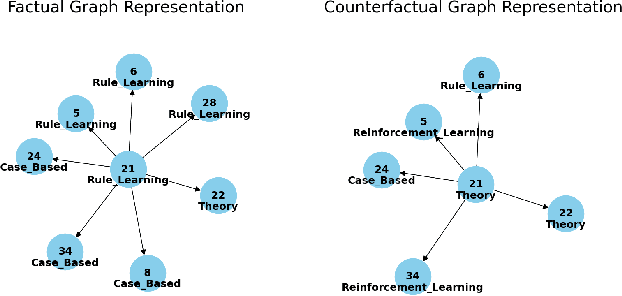



Abstract:Explainable Artificial Intelligence (XAI) has emerged as a critical area of research to unravel the opaque inner logic of (deep) machine learning models. Among the various XAI techniques proposed in the literature, counterfactual explanations stand out as one of the most promising approaches. However, these ``what-if'' explanations are frequently complex and technical, making them difficult for non-experts to understand and, more broadly, challenging for humans to interpret. To bridge this gap, in this work, we exploit the power of open-source Large Language Models to generate natural language explanations when prompted with valid counterfactual instances produced by state-of-the-art explainers for graph-based models. Experiments across several graph datasets and counterfactual explainers show that our approach effectively produces accurate natural language representations of counterfactual instances, as demonstrated by key performance metrics.
Debiasing Machine Unlearning with Counterfactual Examples
Apr 24, 2024Abstract:The right to be forgotten (RTBF) seeks to safeguard individuals from the enduring effects of their historical actions by implementing machine-learning techniques. These techniques facilitate the deletion of previously acquired knowledge without requiring extensive model retraining. However, they often overlook a critical issue: unlearning processes bias. This bias emerges from two main sources: (1) data-level bias, characterized by uneven data removal, and (2) algorithm-level bias, which leads to the contamination of the remaining dataset, thereby degrading model accuracy. In this work, we analyze the causal factors behind the unlearning process and mitigate biases at both data and algorithmic levels. Typically, we introduce an intervention-based approach, where knowledge to forget is erased with a debiased dataset. Besides, we guide the forgetting procedure by leveraging counterfactual examples, as they maintain semantic data consistency without hurting performance on the remaining dataset. Experimental results demonstrate that our method outperforms existing machine unlearning baselines on evaluation metrics.
$ abla τ$: Gradient-based and Task-Agnostic machine Unlearning
Mar 21, 2024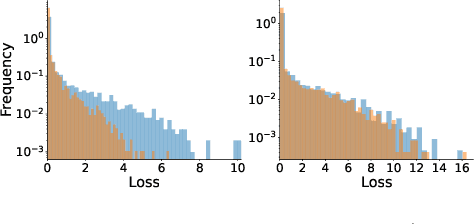
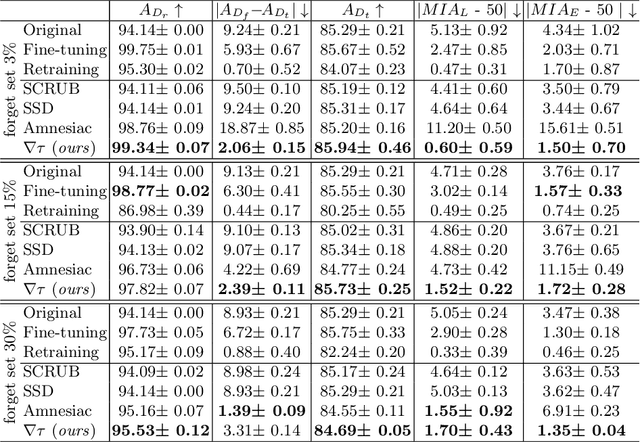
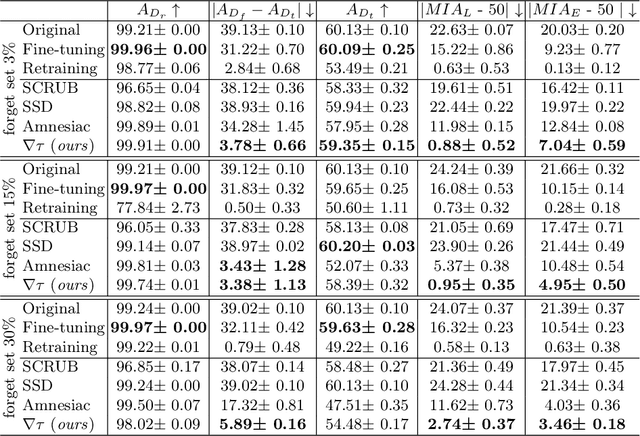
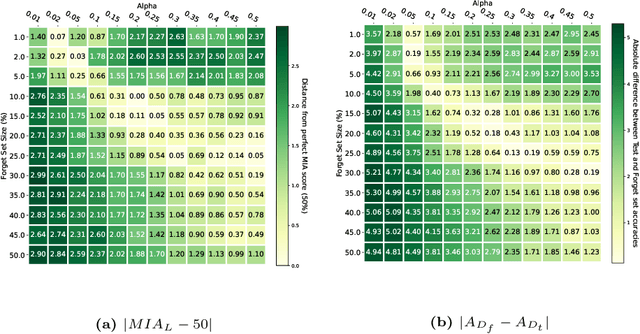
Abstract:Machine Unlearning, the process of selectively eliminating the influence of certain data examples used during a model's training, has gained significant attention as a means for practitioners to comply with recent data protection regulations. However, existing unlearning methods face critical drawbacks, including their prohibitively high cost, often associated with a large number of hyperparameters, and the limitation of forgetting only relatively small data portions. This often makes retraining the model from scratch a quicker and more effective solution. In this study, we introduce Gradient-based and Task-Agnostic machine Unlearning ($\nabla \tau$), an optimization framework designed to remove the influence of a subset of training data efficiently. It applies adaptive gradient ascent to the data to be forgotten while using standard gradient descent for the remaining data. $\nabla \tau$ offers multiple benefits over existing approaches. It enables the unlearning of large sections of the training dataset (up to 30%). It is versatile, supporting various unlearning tasks (such as subset forgetting or class removal) and applicable across different domains (images, text, etc.). Importantly, $\nabla \tau$ requires no hyperparameter adjustments, making it a more appealing option than retraining the model from scratch. We evaluate our framework's effectiveness using a set of well-established Membership Inference Attack metrics, demonstrating up to 10% enhancements in performance compared to state-of-the-art methods without compromising the original model's accuracy.
Community Membership Hiding as Counterfactual Graph Search via Deep Reinforcement Learning
Oct 13, 2023Abstract:Community detection techniques are useful tools for social media platforms to discover tightly connected groups of users who share common interests. However, this functionality often comes at the expense of potentially exposing individuals to privacy breaches by inadvertently revealing their tastes or preferences. Therefore, some users may wish to safeguard their anonymity and opt out of community detection for various reasons, such as affiliation with political or religious organizations. In this study, we address the challenge of community membership hiding, which involves strategically altering the structural properties of a network graph to prevent one or more nodes from being identified by a given community detection algorithm. We tackle this problem by formulating it as a constrained counterfactual graph objective, and we solve it via deep reinforcement learning. We validate the effectiveness of our method through two distinct tasks: node and community deception. Extensive experiments show that our approach overall outperforms existing baselines in both tasks.
Prompt-to-OS (P2OS): Revolutionizing Operating Systems and Human-Computer Interaction with Integrated AI Generative Models
Oct 07, 2023
Abstract:In this paper, we present a groundbreaking paradigm for human-computer interaction that revolutionizes the traditional notion of an operating system. Within this innovative framework, user requests issued to the machine are handled by an interconnected ecosystem of generative AI models that seamlessly integrate with or even replace traditional software applications. At the core of this paradigm shift are large generative models, such as language and diffusion models, which serve as the central interface between users and computers. This pioneering approach leverages the abilities of advanced language models, empowering users to engage in natural language conversations with their computing devices. Users can articulate their intentions, tasks, and inquiries directly to the system, eliminating the need for explicit commands or complex navigation. The language model comprehends and interprets the user's prompts, generating and displaying contextual and meaningful responses that facilitate seamless and intuitive interactions. This paradigm shift not only streamlines user interactions but also opens up new possibilities for personalized experiences. Generative models can adapt to individual preferences, learning from user input and continuously improving their understanding and response generation. Furthermore, it enables enhanced accessibility, as users can interact with the system using speech or text, accommodating diverse communication preferences. However, this visionary concept raises significant challenges, including privacy, security, trustability, and the ethical use of generative models. Robust safeguards must be in place to protect user data and prevent potential misuse or manipulation of the language model. While the full realization of this paradigm is still far from being achieved, this paper serves as a starting point for envisioning this transformative potential.
A Survey on Decentralized Federated Learning
Aug 08, 2023Abstract:In recent years, federated learning (FL) has become a very popular paradigm for training distributed, large-scale, and privacy-preserving machine learning (ML) systems. In contrast to standard ML, where data must be collected at the exact location where training is performed, FL takes advantage of the computational capabilities of millions of edge devices to collaboratively train a shared, global model without disclosing their local private data. Specifically, in a typical FL system, the central server acts only as an orchestrator; it iteratively gathers and aggregates all the local models trained by each client on its private data until convergence. Although FL undoubtedly has several benefits over traditional ML (e.g., it protects private data ownership by design), it suffers from several weaknesses. One of the most critical challenges is to overcome the centralized orchestration of the classical FL client-server architecture, which is known to be vulnerable to single-point-of-failure risks and man-in-the-middle attacks, among others. To mitigate such exposure, decentralized FL solutions have emerged where all FL clients cooperate and communicate without a central server. This survey comprehensively summarizes and reviews existing decentralized FL approaches proposed in the literature. Furthermore, it identifies emerging challenges and suggests promising research directions in this under-explored domain.
The Dark Side of Explanations: Poisoning Recommender Systems with Counterfactual Examples
Apr 30, 2023


Abstract:Deep learning-based recommender systems have become an integral part of several online platforms. However, their black-box nature emphasizes the need for explainable artificial intelligence (XAI) approaches to provide human-understandable reasons why a specific item gets recommended to a given user. One such method is counterfactual explanation (CF). While CFs can be highly beneficial for users and system designers, malicious actors may also exploit these explanations to undermine the system's security. In this work, we propose H-CARS, a novel strategy to poison recommender systems via CFs. Specifically, we first train a logical-reasoning-based surrogate model on training data derived from counterfactual explanations. By reversing the learning process of the recommendation model, we thus develop a proficient greedy algorithm to generate fabricated user profiles and their associated interaction records for the aforementioned surrogate model. Our experiments, which employ a well-known CF generation method and are conducted on two distinct datasets, show that H-CARS yields significant and successful attack performance.
A Byzantine-Resilient Aggregation Scheme for Federated Learning via Matrix Autoregression on Client Updates
Mar 29, 2023



Abstract:In this work, we propose FLANDERS, a novel federated learning (FL) aggregation scheme robust to Byzantine attacks. FLANDERS considers the local model updates sent by clients at each FL round as a matrix-valued time series. Then, it identifies malicious clients as outliers of this time series by comparing actual observations with those estimated by a matrix autoregressive forecasting model. Experiments conducted on several datasets under different FL settings demonstrate that FLANDERS matches the robustness of the most powerful baselines against Byzantine clients. Furthermore, FLANDERS remains highly effective even under extremely severe attack scenarios, as opposed to existing defense strategies.
 Add to Chrome
Add to Chrome Add to Firefox
Add to Firefox Add to Edge
Add to Edge